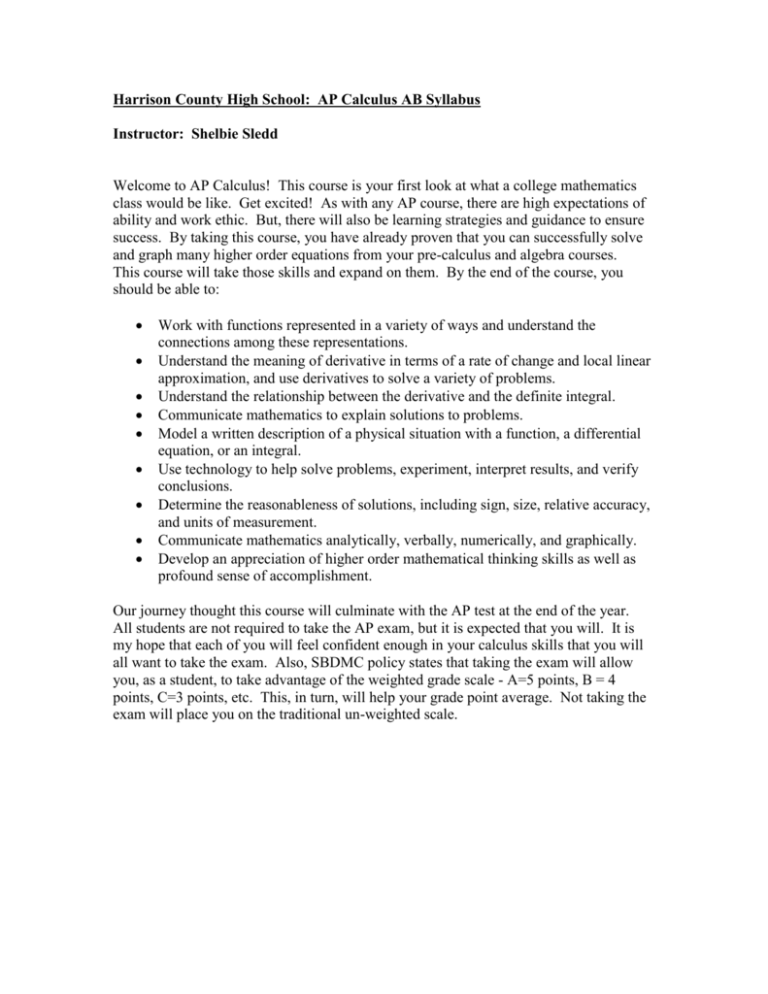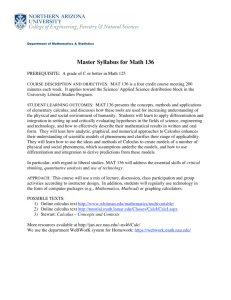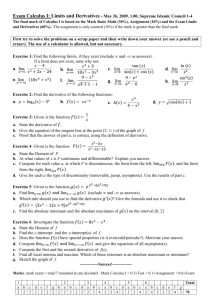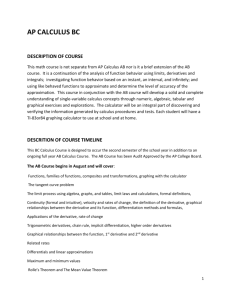AP Calculus AB Syllabus - Harrison County Schools
advertisement

Harrison County High School: AP Calculus AB Syllabus Instructor: Shelbie Sledd Welcome to AP Calculus! This course is your first look at what a college mathematics class would be like. Get excited! As with any AP course, there are high expectations of ability and work ethic. But, there will also be learning strategies and guidance to ensure success. By taking this course, you have already proven that you can successfully solve and graph many higher order equations from your pre-calculus and algebra courses. This course will take those skills and expand on them. By the end of the course, you should be able to: Work with functions represented in a variety of ways and understand the connections among these representations. Understand the meaning of derivative in terms of a rate of change and local linear approximation, and use derivatives to solve a variety of problems. Understand the relationship between the derivative and the definite integral. Communicate mathematics to explain solutions to problems. Model a written description of a physical situation with a function, a differential equation, or an integral. Use technology to help solve problems, experiment, interpret results, and verify conclusions. Determine the reasonableness of solutions, including sign, size, relative accuracy, and units of measurement. Communicate mathematics analytically, verbally, numerically, and graphically. Develop an appreciation of higher order mathematical thinking skills as well as profound sense of accomplishment. Our journey thought this course will culminate with the AP test at the end of the year. All students are not required to take the AP exam, but it is expected that you will. It is my hope that each of you will feel confident enough in your calculus skills that you will all want to take the exam. Also, SBDMC policy states that taking the exam will allow you, as a student, to take advantage of the weighted grade scale - A=5 points, B = 4 points, C=3 points, etc. This, in turn, will help your grade point average. Not taking the exam will place you on the traditional un-weighted scale. RESOURCES AND TECHNOLOGY This course will use Calculus, Seventh Edition, by Larson, Hoestetler, and Edwards, Houghton Mifflin, 2002, as the primary textbook. In addition Calculus, Graphical, Numerical, Algebraic, by Finney, Demana, Waits, and Kennedy, Addison Wesley, 2007, will be used as a reference. Other resources will include but are not limited to AP practice workbooks, Advance Kentucky teacher resource books, and teacher made worksheets. This course will also look at discovery and problems solving using technology. All students will use TI-84 PLUS graphing calculators. You are welcome to purchase your own, but the school will provide one for you if necessary. Teacher demonstrations will also be performed using TI-Nspire teacher software. Demonstrations, learning checks, and some quizzes may be given using TI-Navigator and TI-Nspire. At times, CBL units may be used to model problems. Graphing calculators will have a variety of uses including but not limited to Investigating graphs of functions Finding zeros, intercepts, and extreme values Use of the NDeriv and FNInt features GRADING AP Calculus is designed to most closely model a Calculus course at a college or university. Therefore, the majority of your grade will come from tests and quizzes. Quizzes will be given approximately weekly. Tests will be given at the end of each unit. Longer units may have a test half-way through. At the end of each semester, a cumulative test will be given. This test grade will account for 10% of your grade. Mock AP tests will be given periodically to help you see what type of problems you will face on the actual exam. Homework is VITAL to your survival of AP Calculus. If you do not do the practice problems, you will not be able to participate in class discussions and will not be prepared for class tests or the AP Exam. Homework will be taken up a couple of times a week to ensure you are doing the work necessary to maintain your skill level. COURSE OUTLINE Preliminary Unit: Review of Pre-calculus (2-3 weeks) a. Review of Polynomials: Remainder and factor theorems, recognition b. Review of Functions: End behavior, zeros, intercepts, asymptotes, domain, range c. Trig functions: Unit circle, graphs, inverses Unit 1: Introduction to Calculus (2-3 weeks) a. Exploration Lab: Estimating limits, derivatives, and integrals without calculus b. Finding limits numerically c. Finding slope of a tangent line d. Finding area under a curve Unit 2: Limits (2-3 weeks) a. Exploration Lab: Introduction to Limits of a Function b. Definition of limit c. Properties of limits d. Continuity e. Asymptotes and infinite limits Unit 3: Derivatives (4 weeks) a. Exploration Lab: Relationship Between a Function and Its Derivative b. Derivatives and tangent lines c. Basic differentiation rules d. Rates of change e. Power rule f. Chain rule g. Differentiation with sine and cosine Unit 4: Applications of Derivatives (4-5 weeks) a. Product and quotient rules b. Function behavior and extreme values c. The second derivative test d. Differentiation with remaining trig functions and inverses e. Implicit differentiation f. Related rates g. Optimization Unit 5: Integration (4-5 weeks) a. Exploration Lab: Reimann Sums and the Definite Integral b. Antiderivatives and basic integration rules c. Area and Reimann sums d. Definite integrals e. Mean Value Theorem f. The Fundamental Theorem of Calculus g. Integration by substitution Unit 6: Applications of Integration (3-4 weeks) a. Area between two curves b. Solids of Revolution c. Volume: The disk method d. Volume: The shell method Unit 7: Logarithmic and Exponential Functions (4-5 weeks) a. Differentiation b. Integration c. Average value d. Distance on a line e. Accelerated motion f. Growth and decay g. Slope fields Test Preparation: (2-3 weeks) Post Test Topics: (2-3 weeks) a. L’Hopital’s Rule b. Integration by parts c. Sequences d. Series






